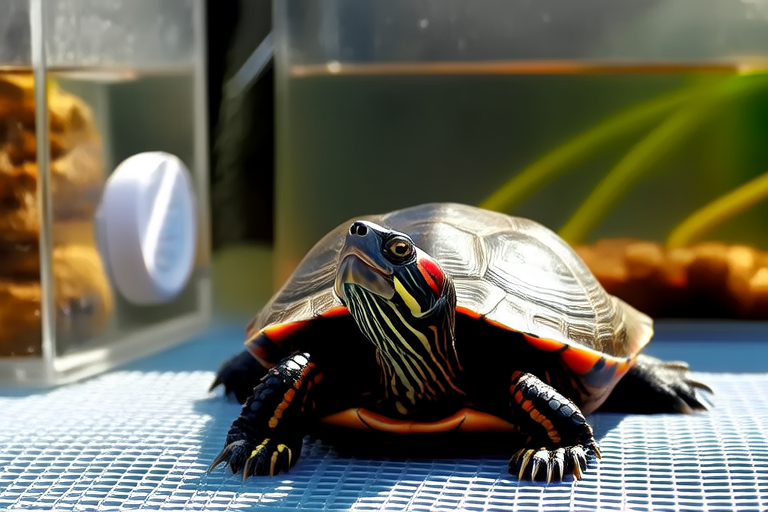Red-eared Slider Care Guide: Tips for First-Time Owners
Welcome to your comprehensive guide to caring for red-eared sliders! These charming turtles are popular pets due to their hardiness and ease of care. However, as with any pet, they require a specific environment and care regimen to thrive. This guide will provide you with all the necessary information to ensure your new friend has a happy and healthy life.
Habitat Setup
Creating the right habitat for your red-eared slider is crucial. Turtles need a large amount of space both in the water and on land. A young turtle can be housed in a 20-gallon tank, but as they grow, so should their living space. An adult slider typically needs a minimum of 40 gallons of water. The tank should have a basking area where the turtle can completely dry off under a heat lamp. The water temperature should range between 75-80°F, and the air temperature above the water should be around 85-90°F during the day, dropping slightly at night.
The water should be filtered to maintain cleanliness and prevent harmful bacteria from building up. UVB lighting is also important; it helps your turtle synthesize vitamin D3, which aids in calcium absorption. Ensure that the light is positioned correctly and replaced every six months to maintain effectiveness.
Substrate in the water area should be easy to clean and non-toxic. Gravel or sand can be used, but avoid small particles that could be ingested. On land, use reptile carpet, bark chips, or smooth pebbles. Provide hiding spots and floating platforms for swimming and resting. Decorative plants and rocks can enhance the environment and stimulate natural behaviors.
Water Quality Maintenance
Maintaining excellent water quality is vital for your turtle’s health. Regularly check water parameters such as pH, ammonia, nitrite, and nitrate levels. Perform partial water changes weekly, removing about 20% of the water and replacing it with fresh, dechlorinated water. Clean the filter regularly and replace parts as needed. Use a water dechlorinator to neutralize chlorine and chloramines, which can harm your turtle.
Invest in a good-quality water testing kit to monitor these levels. If you notice any unusual behavior or signs of illness, check the water quality first, as poor conditions can lead to respiratory infections and shell rot.
Diet Specifics
Red-eared sliders are omnivores with a varied diet. Young turtles require more protein than adults, so their diet should consist primarily of commercial turtle pellets, earthworms, crickets, and occasional feeder fish. As they mature, increase the proportion of plant matter in their diet, including leafy greens like romaine lettuce, dandelion greens, and mustard greens.
Vary the diet to ensure a balanced intake of nutrients. Avoid feeding them iceberg lettuce, as it lacks nutritional value. Fresh vegetables should be finely chopped and offered in small quantities to prevent digestive issues. Offer treats sparingly, such as fruits like strawberries or melon, which can be given once a week.
Ensure that the food provided is appropriate for the size of your turtle. Overfeeding can lead to obesity and related health problems. Feed young turtles daily, while adults can be fed every two to three days. Always remove uneaten food promptly to maintain water quality.
Health Care Basics
Regular veterinary check-ups are essential for maintaining your turtle’s health. Choose a veterinarian experienced with reptiles. Early detection of health issues can prevent serious complications. Signs of illness include lethargy, loss of appetite, swollen eyes, runny nose, and abnormal feces.
Monitor your turtle’s weight and overall appearance. A healthy slider should have clear eyes, active behavior, and a firm, smooth shell. If you notice any abnormalities, consult your vet immediately. Keep a record of any treatments or medications given, and follow the prescribed regimen carefully.
Preventive care includes keeping the environment clean and providing proper nutrition. Quarantine any new additions to your turtle’s environment to avoid introducing diseases. Regular cleaning of the habitat and careful handling can reduce the risk of infections.
Common Behavioral Insights
Understanding your turtle’s behavior can help you provide better care. Red-eared sliders are generally calm and docile, but they may become aggressive if provoked or stressed. They are most active during the day and enjoy basking in the sun or under a heat lamp. Encourage natural behaviors by providing ample space and enrichment items.
Turtles are territorial and may show aggression towards other turtles, especially during feeding times. Monitor interactions closely, particularly when introducing new turtles into the habitat. They may also exhibit head bobbing or biting as a form of communication or territorial display. These behaviors are usually harmless but should be managed to prevent injury.
Handle your turtle gently and infrequently to minimize stress. Use two hands to support its body and avoid grabbing it by the tail or limbs. Always wash your hands before and after handling to prevent the spread of germs.
Long-Term Commitment
Owning a red-eared slider is a significant long-term commitment. These turtles can live for 20 to 40 years, sometimes even longer. Be prepared to provide consistent care over many decades. Research thoroughly before bringing one home to ensure you can meet their needs.
Consider the cost of supplies, equipment, and veterinary care. Set aside funds for unexpected expenses. Plan for potential changes in your living situation that might affect your ability to care for your turtle. Responsible ownership involves being committed to the animal’s well-being throughout its entire lifespan.
Conclusion
Caring for a red-eared slider is an enriching experience that brings joy and companionship. By setting up the right habitat, maintaining water quality, providing a balanced diet, and understanding your turtle’s health and behavior, you can ensure a long and happy life together. Remember, this is a lifelong commitment, so approach it with thoughtfulness and dedication. Enjoy the journey of raising your new friend!
